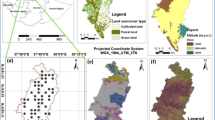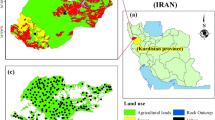Abstract
This study was carried out on arable lands of the central and eastern Black Sea regions including eight provinces (Artvin, Giresun, Gümüşhane, Ordu, Rize, Samsun, Sinop, and Trabzon). The present study aims to generate a soil fertility map for agricultural lands in the central and eastern parts of the Black Sea region. The main objective of this research is to quantify soil fertility by developing a soil fertility index (SFI) model at the regional level. The related objectives were to map the spatial distribution of soil fertility by using auxiliary variables and to model soil fertility within the study region. To accomplish this, a data set for soil fertility differences was collected and a model was developed to predict the spatial distribution of differences across the region. The study area was divided into 2.5 × 2.5-km grid squares. A total of 3400 soil samples were collected from the surface (0–20 cm) of each grid intersection point. The geostatistical method was used to generate the SFI distribution map of the study area for surface soils. Of the total study area, 93.76% had good (S1) or moderately fertile (S2) soil while 6.15% of the area had marginally fertile (S3) soil. Only a very small area (N) had low-fertility soil.




Similar content being viewed by others
References
Abbott LK, Murphy DV (2003) Soil biological fertility—a key to sustainable land use in agriculture. Kluwer Academic Publishers, The Netherlands, p 264 Reprinted 2007
Arshad MA, Martin S (2002) Identifying critical limits for soil quality indicators in agro-ecosystems. Agriculture Economic and Environment 88:153–160
Baskan O, Dengiz O (2008) Comparison of traditional and geostatistical methods to estimate soil erodibility factor. Arid Land Research Management 22:29–45
Boruvka L, Vacek O, Jehlick J (2005) Principle component analysis as a tool to indicate the origin of potentially toxic elements in soils. Geoderma 128:289–300
Burgess TM, Webster R (1980a) Optimal interpolation and isarithmic mapping of soil properties. The semivariogram and punctual kriging Journal of Soil Science 31:315–331
Burgess TM, Webster R (1980b) Optimal interpolation and isarithmic mapping of soil properties. Block kriging Journal of Soil Science 31:333–341
Dengiz O, Ozcan H, Köksal ES, Baskan O, Kosker Y (2010) Sustainable natural resource management and environmental assessment in the salt lake (tuz golu) specially protected area. Environ Monit Assess 161:327–342
Di HJ, Trangmar BB, Kemp RA (1989) Use of geostatistics in designing sampling strategies for soil survey. Soil Sci Soc Am J 53:1163–1167
FAO (1990) Micronutrient, Assessment at the Country Level. An International Study. FAO Soil Bulletin by Sillanpaa, Rome
FAO (2006) Plant nutrition for food security. A guide for integrated nutrient management. Fertilizer And Plant Nutrition Bulletin:16, pp 366 Rome
GS+ (2007) Geostatistics for the Environmental Sciences, Gamma design software, Plainwell, MI, USA
Hazelton P, Murphy B (2007) Interpreting soil test results. What do the numbers mean? Csiro Publishing, Australia 152 p
Isaaks HE, Srivastava RM (1989) An introduction to applied geostatistics. Oxford University Press, New York, pp 10016–14314
Kavitha C, Sujatha MP (2015) Evaluation of soil fertility status in various agro ecosystems of Thrissur District, Kerala, India. International Journal of Agriculture and Crop Sciences 8:328–338
Kravchenko A, Bullock DG (1999) A comparative study of interpolation methods for mapping soil properties. Agron J 91:393–400
Leenaers H, Okx JP, Burrough PA (1990) Comparison of spatial prediction methods for mapping floogplain soil pollution. Catena 17:535–550
Lindsay WL, Norvell WA (1978) Development of a DTPA soil test for zinc, iron, manganese and copper. Soil Sci Soc Am J 42:421–428
Loganathan P, Hedley MJ, Wallace GC, Roberts AHC (2001) Effect of soil cultivation and winter pugging on fluorine distribution in soil profiles under pasture following long-term applications of phosphate fertilizers. Environ Pollut 115:275–282
Lu D, Moran E, Mausel P (2002) Linking amazonian secondary succession forest growth to soil properties. Land Degrad Dev 13:331–343
Miháliková M, Özyazici M, Dengiz O (2016) Mapping soil water retention on agricultural lands in central and eastern parts of the Black Sea region in Turkey. J Irrig Drain Eng. doi:10.1061/(ASCE)IR.1943-4774.0001094
Moran EF, Brondizion ES, Tucker JM, Da Silva-Forsberg MC, McCracken S, Falesi I (2000) Effects of soil fertility and land use on forest succession in Amazonia. For Ecol Manag 139:93–108
Mueller TG, Pierce FJ, Schabenberger O, Warncke DD (2001) Map quality for fertility management. Soil Sci Soc Am J 65:1547–1558
Mukashema A. (2007) Mapping And Modelling Lanscape-Based Soil Fertility Cahange in Relation To Human Induction. Case Study, Gishwati Watershed of the Rwandan Highlands. Msc tehesis, ITC, Netherlands, 75 p
Nadeau MB, Sullivan TP (2015) Relationships between plant biodiversity and soil fertility in a mature tropical Forest, Costa Rica. International Journal of Forestry Research, DOI http://dx.doi.org/10.1155/2015/732946
Nair PKR (1993) An introduction to agroforestry. Kluwer, Dordrecht
Nair PKR, Kang BT, Kass DBL (1995) Nutrient Cycling and Soil Erosion Control in Agroforestry System. In Agriculture and Environment: Bridging Food Production in Developing Countries, ASA Special Publication No. 60, American Society of Agronomy, Madison, Wisconsine, Ch. 7
Nelson DW, Sommers LE, (1982) Total Carbon, Organic Carbon and Organic Matter. In: Page, L.A., Miller, R.H., Keeney, D.R (Eds.), Methods of Soil Analysis, Part 2. Chemical and Microbiological Methods (2 nd ed) American Society of Agronomy, Madison, 539–579 p
Ozyazici MA, Dengiz O, Saglam M, Erkocak A, Mihalikova M (2014). Minimum data set analysis in hazelnut areas using multivariate statistics and geostatistics methods. Proceedeings of 9th International Soil Science Congress on “The Soul of Soil and Civilization”, p. 602–61
Özyazıcı MA, Dengiz O, Aydoğan M, Bayraklı B, Emel Kesim E, Urla Ö, Hakan Yıldız H, Ünal E (2016) Levels of basic fertility and the spatial distribution of agricultural soils in central and eastern Black Sea region. Anadolu Journal of Agricultural Sciences 31(1):136–148
Panwar P, Pal S, Reza SK, Sharma B (2011) Soil fertility index. Soil Evaluation Factor, and Microbial Indices under Different Land Uses in Acidic Soil of Humid Subtropical India, Communications in Soil Science and Plant Analysis 42:2724–2737
Park SJ, Vlek PLG (2002) Environmental correlation of three-dimensional soil spatial variability: a comparison of three adaptive techniques. Geoderma 109(1–2):117–140
Perkin E (1990) Analytical for atomic absorption Spectro photometry. Perkin Elmer, Norwalk
Ravikumar P, Somashekar RK (2013) Evaluation of nutrient index using organic carbon, available P and available K concentrations as a measure of soil fertility in Varahi River basin, India. Proceedings of the International Academy of Ecology and Environmental Sciences 3(4):330–343
Robertson GP (2008) GS+. Geostatistics for the Environmental Sciences. Gamma Design Software, Plainwell, Michigan, USA
Saglam M (2014) Evaluation of the physicochemical properties of alluvial and colluvial soils formed under ustic moisture regime using multivariate geostatistical techniques. Arch Agron Soil Sci 61(7):943–957
Saglam M, Dengiz O (2015) Similarity analysis of soils formed on limestone/marl-alluvial parent material and different topography using some physical and chemical properties via cluster and multidimensional scaling methods. Environ Monit Assess 187:100. doi:10.1007/s10661-014-4226-3
Sağlam M, Dengiz O, Sarıoğlu FE, Saygin F (2014) Mapping and modelling of soil fertility change based on a geostatistical approach in vertisol developed on the Bafra deltaic plain. Transactions of the Royal Society of South Africa 69:1–9
Saglam M, Dengiz O, Sargin F (2015) Assessment of Horizantal and vertical variabilities of soil quality using multivariate statistics and geostatistical methods. Commun Soil Sci Plant Anal. doi:10.1080/00103624.2015.1045596
Setia R, Verma V, Sharma P (2012) Soil informatics for evaluating and mapping soil productivity index in an intensively cultivated area of Punjab, India. J Geogr Inf Syst 4:71–76. doi:10.4236/jgis.2012.41010
Soil Survey Staff (1992) Procedures For Collecting Soil Samples and Methods of Analysis For Soil Survey. Soil Survey Investigations Report No. 42, Washington DC, USA
Whelan BM, McBratney AB, and Rossel RA (1996) Spatial prediction for precision agriculture. Proceedings of the 3rd International Conference on Precision Agriculture, p.331–342
Wikipedia. (2013) Black Sea Region. Wikipedia free encyclopaedia
Wolf B (1971) The determination of boron in soil extracts, plant materials, composts, manures, water and nutrient solutions. Communication Soil Science and Plantn 2:363–374
Acknowledgements
The authors thank Gregory T. Sullivan of the School of Geography, Planning and Environmental Management at The University of Queensland in Brisbane, Australia, for editing the English in an earlier version of this manuscript. In addition, the authors gratefully acknowledge the scientific research grant (TAGEM-BB-080202H1) from the General Directorate of Agricultural Research and Policies of Republic of Turkey Ministry of Food, Agriculture and Livestock. Moreover, the authors thank sincerely the anonymous reviewers for their constructive comments which contributed to improve our work.
Author information
Authors and Affiliations
Corresponding author
Rights and permissions
About this article
Cite this article
Arif Özyazici, M., Dengiz, O., Sağlam, M. et al. Mapping and assessment-based modeling of soil fertility differences in the central and eastern parts of the Black Sea region using GIS and geostatistical approaches. Arab J Geosci 10, 45 (2017). https://doi.org/10.1007/s12517-016-2819-6
Received:
Accepted:
Published:
DOI: https://doi.org/10.1007/s12517-016-2819-6




